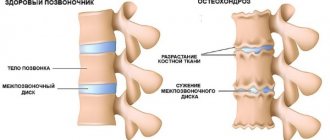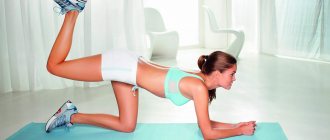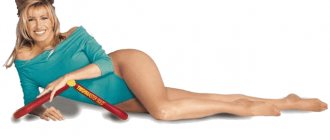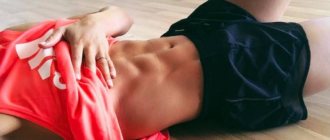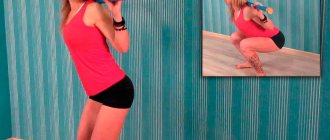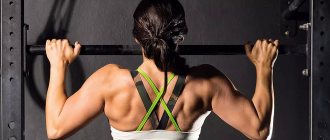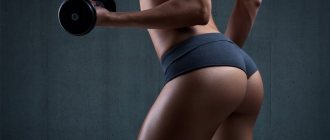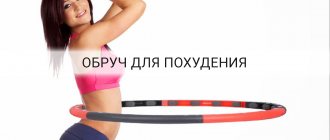A gymnastic stick is often used during fitness classes. Despite its apparent simplicity, it is possible to perform interesting exercises for various muscle groups. Due to its availability, it is widely used in gyms, as well as at home.
This sports equipment not only strengthens muscles, but also promotes weight loss.
Characteristics of a gymnastic stick
This sports equipment comes in different sizes and may also vary in weight.
Depending on your preparation and training goals, you can choose the appropriate option:
- If the workout is strength training, then it is recommended to use a bodybar . It has a metal base that is covered with rubber. The size varies from 0.9-1.2 m, weight from 1.5 to 16 kg.
- When doing gymnastics, a light stick made of plastic is suitable. It's hollow inside. The length can be 90, 120 or 150 cm.
- There are gymnastic sticks of smaller dimensions. They are suitable for training with children.
Characteristics of projectiles
Depending on their purpose, sticks can have different sizes and weights.
When strength training, equipment with a metal base covered with rubber is most often used. Their weight is approximately one and a half kilograms, their size is on average one meter.
For gymnastic exercises, athletes choose light poles. Their light weight is due to the material from which they are made. This is usually plastic. The size of such equipment varies greatly - from 90 centimeters to one and a half meters.
There are variations of equipment for children. They have smaller dimensions.Rules for performing exercises with a gymnastic stick
Doing the exercises correctly will give you the best results and will protect you from getting injured or sprained.
There are some starting positions for different workouts:
- The gymnastic stick is in front of you. This position involves arms straightened horizontally.
- Above your head - arms straight, positioned vertically. The projectile is in the palms.
- In front of the chest is a projectile in outstretched arms. The elbows are slightly apart. The stick is located at just below shoulder level.
- The gymnastic stick can be placed behind the head, resting on the shoulders . In this position it must be held with your hands. The projectile should not put pressure on the cervical vertebrae. He goes down a little lower.
- The gymnastic apparatus is located below, at the level of the lowered arms.
Also, different types of grip can be used for different exercises:
- Straight grip (or regular). Hands are placed palms down.
- Reverse grip - palms facing up.
- There can also be a wide or narrow placement of the palms.
- In some situations, you need to hold the gymnastic stick directly by the edges. Sometimes it should be positioned vertically, resting one end on the floor.
How to work with a gymnastic stick correctly
This simple sports equipment, familiar from school days, helps increase the effectiveness of training. A gymnastic stick allows you to evenly distribute the load across different muscle groups. In addition, it can be used to add variety to sports activities.
But beginners who do not have a sufficient level of physical fitness should be careful with the stick. If you do not follow the technique of using gymnastic equipment, you may encounter various injuries. Therefore, it is necessary to figure out how to use it correctly for classes.
Gymnastic poles
To perform exercises with a gymnastic stick, two types of grip are usually used:
- Straight. It won’t be difficult to master: you need to take the projectile so that the back of your hand faces up. In this case, it turns out that the brush completely covers the stick.
- Back. It is also called an underhand grip. You just need to change the position of your palms in the opposite direction: now the back side looks down, and the fingers are on top.
Different types of grips
The appropriate type of grip depends on the exercise you are performing at the moment. It can change several times during one workout.
Expert opinion
Yulia Mikhailova
Nutrition expert
Before starting the exercises themselves, experienced athletes recommend taking time to warm up. Running, jumping rope, bending, turning the torso, head, arms and legs are perfect for warming up.
It is also worth choosing the right time for exercising with a gymnastic stick. Such training, like any other type of physical activity, is best not done too late. In this case, there is a risk of experiencing insomnia. Therefore, if a lesson is scheduled for the evening, it should end no later than a couple of hours before going to bed.
As for nutrition, it is better not to have a heavy lunch before starting training with a gymnastic apparatus. A light snack is good, it will charge you with energy and prevent you from running out of energy quickly. But if you still have a hearty meal, then you should not start training earlier than two hours after it.
Since exercises with a gymnastic stick are a more difficult option than without it, it is important to correctly assess your strength and not overwork yourself. You don’t need to give the maximum load right away, it’s better to increase it gradually. You must independently choose the number of repetitions of each exercise depending on your level of physical fitness. But all athletes advise starting with ten.
We recommend reading the article about video for weight loss. From it you will learn about the benefits of a gymnastic roller for weight loss, the advantages and disadvantages of a gymnastic apparatus, exercises for the abs, abdomen and sides. And here is more information about exercises for a thin waist.
When and how to train?
There are no special restrictions on the use of such exercises. Everyone can create a program for themselves.
But, some points should be taken into account:
- To get the maximum effect, it is advisable to train with a gymnastic stick 3-4 times weekly. Their minimum duration is 30-40 minutes.
- It is advisable to take short breaks between workouts. For example, do exercises every other day. This regime will allow the muscles to recover and will not overload the body.
- For inexperienced athletes, it is necessary to gradually reach their maximum load. To begin with, it is important to master the correct technique. During the first workouts, it is recommended to perform each exercise 10 times (1-2 approaches). Taking into account how you feel, you can increase the number of repetitions, add approaches and increase the amplitude.
It is necessary to carry out training at least 1.5-2 hours after eating . If training is carried out in the evening, then the interval between its completion and sleep should be at least 2 hours.
Gymnastics with a stick for children
Gymnastics with this sports equipment is useful and effective for children. It has a beneficial effect on the spine. To prevent problems with the spine, you should regularly perform morning exercises using a stick.
Recommended list of exercises for children with a gymnastic stick:
- The stick is fixed in a vertical position. The child grabs the object with his hands and climbs up, then slowly falls down.
- The stick is held in the hands behind the back. Bend forward with the body, it is important to reach for the feet.
- Walking with a gymnastic stick behind your back on your shoulders. Hands can be on the object or straightened.
What do you need to know before doing the exercises?
Before starting classes, it is recommended that you familiarize yourself with certain requirements that will help you carry out the training correctly and not harm the body:
- Be sure to warm up and warm up your joints.
- If you experience problems with the musculoskeletal system , spine, or other problems, you should consult your doctor. He must approve and approve the training program or adjust it.
- If your physical fitness is very weak or your body’s condition does not allow you to fully perform gymnastics, you can first perform several exercises without a stick so that your joints and muscles get used to it a little. Then use the gymnastic stick as provided in the health program.
Benefits of exercise
The benefits of training with this simple equipment are undeniable:
- Allows you to load different parts of the body.
- It has a beneficial effect on the spine and trains the back.
- Improves stretching and agility.
- Tones the body and helps in the fight against excess weight.
- Symmetrically loads the muscles and promotes good coordination.
- Strengthens the muscle corset.
- Helps normalize blood circulation.
- Used in rehabilitation and recovery programs.
Exercises while standing
Lesson plan and list of exercises:
- The feet are placed at the level of the pelvis. The gymnastic stick is located behind the head. It is necessary to turn the body from side to side. The pace of the exercise is smooth and measured.
- Stand up and place your feet at a distance from each other. The gymnastic apparatus is raised up and held above the head. Tilt your torso alternately left and right. The projectile must not move from the vertical plane.
- The gymnastic stick is again located above the head. Only now the torso is tilted forward. The body from the waist to the top is straightened in a straight line. Then you need to lean back.
- Place the equipment just above the lower back, holding it with your elbows. The feet are located nearby. Take one of them to the side and pull out its toe, resting it on the floor. Tilt your torso in the same direction as your leg is pointing. Take the starting position, repeat for the other side.
- Stand up straight, spread your legs to the sides. Gymnastic stick in front of you in straight hands. Leave the position of your hands unchanged, while doing squats. In this exercise, you can change the position of your feet, leave them parallel, or turn your toes slightly outward. Lunges are performed from the same starting position.
- Place the gymnastic apparatus in height at arm's length, resting one end on the floor. Place both palms on its upper edge. The elbows do not bend. Bend your body forward with emphasis on the gymnastic stick. A slight arch forms in the back. It needs to be increased by making several springy vertical movements. Climb back up. Do the exercise again.
Exercises while sitting
- Sit down with your legs stretched out in front of you. The feet are shoulder-width apart. Place the projectile on the shoulders. Bend your body, aiming for your legs. It is necessary to spring slightly, increasing the angle of inclination. The back is straight. Take the starting position, then tilt again.
- Sitting position, legs in front of you, feet not touching. You need to turn your torso to the side and move the gymnastic apparatus upward, straightening your arms. Turn around and lower the stick. Repeat the exercise on the other side.
Exercises while lying down
In lying exercises, the legs should not bend at the knees. If you are lifting your body or legs, then at the top point you need to linger for 2-3 seconds and fix the position.
- You need to lie on your stomach. Gymnastic stick in front of you in arms outstretched forward. Legs don't touch. Raise the projectile with straight arms. At the same time, raise your head slightly. Then raise your body above the floor, bending your lower back, and place the stick on your shoulders. At the point of maximum tension, linger for 3-4 moments. Take the starting position. Run several times.
- Lie on your stomach. Gymnastic stick in hands, behind back. It is located below the pelvis. Lift your body off the floor as much as possible and look forward. At the same time, raise your arms up. Stay in this position for a while. Then return to the starting point and repeat again.
- Starting position as in the second exercise. Perform the same lift of the torso and stick. In this case, you also need to raise one leg. The knee is bent. Try to reach the gymnastics stick with the toe of this foot. Return to a lying position and repeat the exercise.
- Lie on your back. Hold the gymnastic stick in your hands, at chest level. Lift it up. Bend your knees and bring them closer to the stick, then put your feet behind the apparatus. As a result, the stick ends up behind your back. Lay it on the floor. Stretch your legs up, performing a “birch tree”. Lower your knees to your chest. Take the stick in your hands and return to the starting position in the same way. Repeat several times.
Flexibility and stretching exercises
- Stand up straight. Feet shoulder width apart. Gymnastic stick in hands, behind back. Arms straight. Place your palms with a narrow grip in the middle of the projectile. Arch your back, keeping the position of your arms unchanged. When the muscles are as tense as possible, hold for a few seconds. Then relax and repeat again.
- Starting position as in the first exercise. The grip changes, in this case it is wide (wider than the shoulders). Palms turned outward. Slowly raise your arms up. The back remains straight. Perform the exercise slowly. With its help, the rear deltas are stretched.
- Stand up straight. Gymnastic stick in front of you. Lift one edge up while lowering the other. At the maximum point, the arms are crossed. Repeat with the other side. Advanced athletes can hold their arms overhead during this exercise. To do this, flexibility must be well developed and the joints must be prepared.
- From a standing position, lift the stick with outstretched arms. Swipe over your head and bring it as far back as possible. Bring your hands back and repeat. Perform the exercise slowly, without jerking. Do not force it if discomfort or pain occurs.
- Do everything as in the previous exercise. At the moment when your hands with the stick are behind your back, you need to raise one leg and reach the stick with its toe. Then reach with your other leg. After this, return to the starting position.
Exercises with a stick
There are many types of exercises with a stick. It is important to understand that for certain purposes and for different ages they will be different.
Warm-up
Any physical activity must begin with a warm-up to prepare your body.
Warm-up includes:
- jumping (you can use a jump rope) - 5-7 minutes;
- squats - 15 times;
- running - 7-10 minutes;
- stretching (all muscle groups);
- warming up your arms and legs.
All classes should gradually become more difficult. The volume of load and the number of approaches must necessarily increase over time.
Exercises while standing
When working in a standing position, you must follow certain rules.
Among which:
- Feet shoulder width apart.
- Perform movements while exhaling.
- The number of repetitions is at least 6 times.
If you follow all the rules, your training will be more productive.
Exercise No. 1
Standing position, feet shoulder-width apart.
Execution order:
- Raise your arms above your head. Hold the equipment with a wide grip.
- Slowly rotate your arms horizontally without lowering the stick.
- After crossing completely, return your arms to the starting position.
Repeat 15-20 times.
Exercise No. 2
Standing position, feet shoulder-width apart, stick perpendicular to the floor.
Execution rules:
- Tilt your body forward, leaning on the projectile.
- Return to starting position.
You can increase the load by adding swaying of the torso up and down.
Exercise No. 3
Feet are placed at pelvic level, equipment behind the head.
The body should be rotated from side to side.
The pace is smooth and measured.
Exercise No. 4
Feet shoulder width apart. The gymnastic apparatus is raised up above the head.
Tilt your torso left and right. The projectile must not move from the vertical plane.
Exercise No. 5
The situation is the same. The projectile is in front of the chest in straight arms. Do squats.
You can change the position of your feet, leave them parallel, or turn your toes slightly outward.
Lunges are performed from this starting position.
In a sitting position
While sitting, you can perform many exercises and vary them at your own discretion.
Two main ones:
- sit down and stretch your legs. The feet are shoulder-width apart. Place the projectile on the shoulders. Bend your body, aiming for your legs. It is necessary to spring slightly, increasing the angle of inclination. The back is straight. Take the starting position, then tilt again;
- sitting position, legs in front of you, feet not touching. You need to turn your torso to the side and move the gymnastic apparatus upward, straightening your arms. Turn around and lower the stick. Repeat the exercise on the other side.
In these types of exercises, it is important to monitor the position of your back. It must be straight.
Lying down
When working lying down, your legs should not bend at the knees.
Exercise No. 1
Lying on your stomach.
Projectile in front at outstretched arms:
- Raise the projectile with outstretched arms, while raising your head.
- Raise your body by arching your lower back.
- Hold the body in this position for 3-4 seconds.
Do at least 10 approaches.
Exercise No. 2
Lying on your stomach. The equipment is behind the back, at a level just below the pelvis.
You should raise your body and at the same time raise your arms up. Stay in this position for 3-4 seconds, your gaze should be directed forward.
Repeat 10-15 times.
Exercise No. 3
Lying on your back. The projectile is at chest level.
You need to lift it up (at chest level), bend your knees and bring them closer to the stick.
To complicate the exercise, you can put your feet behind the apparatus so that it is behind your back.
Or simply perform the usual “birch”, holding the stick at the top at chest level.
For flexibility and stretching
Flexibility and stretching exercises should be performed very carefully so as not to injure the muscles. It is better to increase their number gradually. And properly prepare the body for them.
Exercise No. 1
Standing position. Gymnastic stick behind your back. Arms straight. Hold the projectile with a narrow grip in the center.
You should bend your back, leaving the position of your hands in their original state. Hold your torso in this state for 5 seconds. Gradually increase this time.
Exercise No. 2
Starting position, as in the first exercise. Change the grip to wide.
You should slowly raise your arms up and fix them in the most uncomfortable position for 5-7 seconds. Then repeat.
Exercise No. 3
From a standing position, lift the projectile with outstretched arms. Swipe over your head and bring it as far back as possible. Bring your hands back and repeat.
Do it slowly. Do not force it: if discomfort or pain occurs, you should stop immediately.
For osteochondrosis
Osteochondrosis haunts people who lead a sedentary lifestyle. Gymnastics with a stick helps to quickly and effectively get rid of the disease. To restore all the necessary functions of the spine, training should be carried out systematically and efficiently.
Therapeutic exercises with a stick for the back:
- Stand straight. Inventory in front of you. It is worth holding it by the edges. From this position, turn your torso in different directions. Do not change the position of your hands throughout the execution.
- The situation is the same. We raise our hands together with the stick above our heads and return them back. Do not bend your elbows.
- Starting position: standing. Hands hold the projectile above your head. You need to inhale and at the same time tilt your body forward. The lower back bends. You need to touch the floor with the stick. Then straighten back up, exhaling.
It is worth understanding that this list is therapeutic, not preventive.
It is better to coordinate this complex with your doctor, since only he will be able to advise on the level of load and frequency of implementation.
With a stick and expander
An expander can be considered a special rubber band. It allows you to increase the load during training several times.
Exercise No. 1
The projectile is on the shoulders. The expander is attached at the edges. The feet keep the middle of the expander on the floor.
You need to do squats. Repeat the exercise 20-25 times.
Exercise No. 2
Get on all fours with emphasis on your palms. Shell in hand.
The expander is attached to the edges of the stick, and the middle of it clings to the heels.
Perform leg swings back and up alternately for each leg.
The optimal number of repetitions is 15 times on each leg.
Exercise No. 3
Deadlift, but instead of a barbell a gymnastic stick is used. The increase in load occurs due to the expander, which is held by the feet.
For children
Exercises with gymnastic equipment are useful for both adults and children of all ages. In many schools and kindergartens, exercise therapy classes are carried out exclusively with the help of such a stick.
Exercise No. 1
The next exercise is performed standing. Stick on lowered hands.
It needs to be raised in front of you, then above your head, then again in front of you and lowered down.
When performing this, the child should be instructed that he must hold in each position for 3-5 seconds.
Exercise No. 2
Hold the stick with a wide grip. Rise on your toes and at the same time lift the stick above your head with outstretched arms.
Repeat this 5-10 times.
Special instructions: during the execution, the heels should be kept together, the gaze should be directed upward.
Exercise No. 3
Starting position: standing. The stick is raised in front of you.
Execution order:
- Take one leg back.
- Raise the stick up without taking your eyes off it.
- Return to starting position and repeat on the other side.
The working leg is pulled back without bending the knee, the toe is turned outward.
For the elderly
With age, the condition of the spine and muscles begins to deteriorate. Therefore, it is very important not to ignore exercise therapy classes.
List of simple exercises that can be done while standing for older people:
- Gymnastic apparatus in lowered hands. Feet together. Raise the projectile up, lower your head. Take the starting position. Repeat the exercise.
- Feet shoulder width apart. The projectile is held in straight hands above the head. The grip is wide. Perform body tilts alternately in different directions.
- Instead of bending, turn your body in different directions.
People of retirement age should consult a specialist before training. You can add new exercises, but the load should be reduced by at least 2 times.
Paired with
To work in pairs, you need to choose a suitable partner. To perform the exercise, it is very important that the physical parameters of people match. Physical level preparation should also be the same.
Exercise No. 1
The partners are facing each other. Sticks in hands at chest level.
Everyone tries to push the right end of the stick forward, while simultaneously holding resistance with their left hand.
Exercise No. 2
Position: sitting facing each other. Task: pull the projectile, holding it by the ends.
Exercise No. 3
Starting position: standing opposite your partner. Sticks down along the thigh. Each of them is held at different ends by both partners. Raise one stick sideways, the other up. Then change movements for the other side.
Exercises with a gymnastic stick for osteochondrosis
This set of exercises is therapeutic in nature, and not just recreational. People with a sedentary lifestyle are susceptible to osteochondrosis. In this mode, muscles gradually lose their elasticity.
The following exercises will help in the fight against this disease:
- Stand straight. Gymnastic stick in front of you. You need to hold it by the edges. From this position, turn your torso in different directions. Do not change the position of your hands throughout the execution.
- The position of the first exercise remains unchanged. It is necessary to raise your hands together with the stick above your head and return them back. Do not bend your elbows.
- Do the second exercise. At the same time, monitor your breathing. Inhale as you raise your arms, exhale as you lower them. Breathing is deep and measured.
- Stand up straight. Hands hold a gymnastic stick above your head. It is necessary to inhale and at the same time tilt the body forward. The lower back bends. You need to touch the floor with the stick. Then straighten back up, exhaling.
These 4 exercises are considered basic. They can be performed not only for treatment, but also as prevention.
Important: This set of exercises is prescribed by your attending physician. It takes into account which area of the spine suffers from the disease and calculates the norm of permissible loads.
Exercises with a stick and expander
- The gymnastic stick is on the shoulders. The edges of the expander are attached to its edges. Feet shoulder-width apart, feet holding the middle of the expander on the floor. From this position, perform squats.
- Get on all fours with emphasis on your palms. The stick is held in the hands. The expander takes the form of a loop, the middle of which is hooked to the heels, and the edges are held on a stick. Swing your leg back and up, overcoming the resistance of the expander. Perform the exercise alternately for each leg.
- Perform deadlifts. Instead of a barbell, he holds a gymnastic stick in his hands. The expander is held by the feet. When lifted up, it stretches, providing resistance.
- Perform squats as in the first exercise. In a straightened position, you need to lift the gymnastic stick up above your head. At the same time, the expander stretches even more and provides greater resistance.
In addition to the expander, you can also use a fitball for exercise.
The value of exercise therapy with a stick for osteochondrosis
Exercises are primarily aimed at strengthening and developing the muscular system, improving blood circulation.
Using a special stick makes it easier for the patient to perform the exercises. This is due to the redistribution of the load - part of it goes to the stick . It also makes it possible to diversify therapeutic training.
A stick is a universal general developmental equipment that can be purchased in any specialized stores.
It has the following effect:
- helps relax the muscles of the affected areas;
- general developmental exercises with its use help prepare for more serious loads;
- can be used for preventive purposes.
Exercises with a gymnastic stick for children
General developmental exercise therapy exercises with a gymnastic stick are useful for both adults and children of any age: small children, preschoolers and schoolchildren. Many preschool institutions conduct lessons with a gymnastic stick.
- Starting position standing. Gymnastic stick in lowered hands. Raise it in front of you. Then overhead. Again in front of you and lower down. While performing this exercise, the child can linger for a few seconds at each stage.
- Stand straight, feet together. Hold the stick down with a wide grip. Rise onto your toes and at the same time lift the projectile above your head. Stay a little longer. Return to starting position. Keep your heels together while performing. The gaze is directed at the stick at the highest point, above the head.
- From a standing position, raise the stick in front of you. Take one leg back. Raise the stick up without taking your eyes off it. Return to starting position and repeat on the other side. The working leg is pulled back without bending the knee, the toe is turned outward.
- Take a sitting position. Gymnastic stick in front of you in straight hands. Draw circles in the air first with one end of the stick, then with the other.
- Stand on one leg. The projectile is in a vertical position. One side rests on the floor, hold the other side with the opposite hand. Leaning on a stick, jump on one leg around it. Having described one circle, change sides while jumping and stand on the other leg. Repeat jumping on the second leg.
Exercise technique
Body rotations
When performing rotations of the body, it is necessary to fix the pelvis, hips and feet in a certain position, without movement.
When performing the exercise, the following muscles are involved:
- press;
- back;
- shoulder joints.
Performing body turns:
- The gymnastic apparatus lies on the shoulders.
- Arms are bent.
- The body turns smoothly in each direction one by one.
With good preparation and endurance, the number of turns in each approach should be increased.
Body tilts to the sides
You should lean to the side using one of two methods.
One way is as follows:
- Gymnastic equipment is placed on the shoulders.
- Your arms should be bent.
- The body tilts to the left, then to the right.
It is forbidden to strain the neck muscles, as tension in this area interferes with the work of other muscle groups.
Body bends with a different grip on the gymnastic apparatus:
- The gymnastic stick is grabbed with both hands using a wide grip.
- The action is performed together with the object, one hand is lowered down, the other is raised up.
- The body tilts down, it is important that the stick is positioned vertically.
- The exercise is repeated in the same way, bending in the opposite direction.
Don't miss the most popular article in the section: Morning exercises for those over 40, 50. Gymnastics exercises for weight loss, video lessons.
Body bends forward
When performing, a body position is used in which the gymnastic stick is on the shoulders.
Performing forward bends:
- The initial position of the body is accepted.
- The body leans forward as much as possible.
- The chin looks exclusively straight, and the body muscles should be tense.
- Next, the body is tilted back, the back should be without deflection.
Lunges and squats
Exercises with lunges and squats are performed with a rear grip, holding the object in front of you.
Performing lunges and squats:
- Any leg of your choice is fixed in place, the other leg is extended forward as far as possible.
- The stick is held in one of the suggested ways.
- In this body position, a slow squat is performed.
- Next, the forward leg is moved back in the same way - again a slow squat.
- The exercise is performed with the other leg in a similar way.
Exercises while lying on your stomach
Exercises from a prone position are included in the complex of exercises with a gymnastic stick.
Step-by-step exercise:
- Pull the stick forward.
- The arms are raised as high as possible in the upward direction.
- The head rises.
- The gymnastic apparatus is brought to the shoulders.
- The chest rises, this position of the body is maintained for as long as possible.
There is an exercise performed in the same position called the boat. When performing this exercise, the projectile is held with your hands along the edges of your feet. It is necessary to simultaneously stretch upward, making a maximum deflection of the body.
Exercises while lying on your back
“Birch” is the most popular exercise from the supine position.
The “birch tree” is performed like this:
- The arms are straight, the stick is held with a wide grip.
- You need to pull your legs towards your chest, bending them at the knees, and pass the exercise under your buttocks.
- The hands with the apparatus are lowered to the floor, the legs are straightened, and it is important to pull the toes up.
- The legs slowly fall.
- Next, you need to repeat the exercise in reverse order.
Flexibility and stretching exercises
A set of flexibility and stretching exercises includes training with a gymnastic stick.
This training includes a list of tasks using various positions:
- Sitting. To perform the exercise, the arms with the apparatus should be straightened. The legs are straight, resting on the feet.
- Bends while standing. Place your legs wide, the stick should be grabbed from behind and parallel to your shoulder blades. It is necessary to bend in each direction while simultaneously swinging your torso with an average amplitude.
- Turns . In a standing position, the gymnastic apparatus is placed in front of the body, arms should be straight. It is necessary to turn the stick so that the arms are crossed alternately in different directions.
- Bringing your arms back . In a standing position, the projectile must be held from below. Hands should be raised and placed back behind the head. Then take the initial position of the body.
Exercises for the elderly
It is never too late to start exercising for older people, both for the general condition of the body and for posture.
List of exercises:
- In a standing position, hold the gymnastic apparatus in your lowered hands. Feet together. Raise the projectile up, lower your head. Take the starting position. Repeat the exercise.
- Feet shoulder width apart. Gymnastic stick in straight hands above your head. The grip is wide. Perform body tilts alternately in different directions.
- Starting position as in the second exercise. Instead of bending, turn your body in different directions.
How to hold a stick correctly
It is important to hold the gymnastic stick correctly, regardless of the chosen set of exercises with this equipment.
There are several main starting points:
- ahead;
- above you with straight arms extended upward;
- in front of the chest, slightly lower relative to the level of the collarbone, while the arms should be spread at the elbows and hold the object;
- behind the head, resting on the shoulders below shoulder level;
- behind the back on the bends of the arms at the elbows;
- behind the back parallel to the waist line;
- behind the back above the waist line;
- at hip level with arms down.
Exercises in pairs
In order to work in pairs, you need to choose a partner who is suitable in terms of physical parameters. There shouldn't be too much difference in weight. It is desirable that the partners be of the same gender and with the same level of training.
Attention : All exercises that involve resistance must be performed taking into account the physical strength and capabilities of the partner. The exercise should not take on a competitive nature.
- Partners stand facing each other. Gymnastic sticks are held in the hands at chest level. Each of them tries to push the right end of the stick forward, while at the same time holding resistance with his left hand.
- Take a sitting position facing each other. Pull the gymnastic stick, holding it by the ends. You can perform this exercise with your feet shoulder-width apart. Or you can connect them together.
- Stand with a friend opposite the arch. Gymnastic sticks on the bottom sides. Each of them is held at different ends by both partners. Raise one stick sideways, the other up. Then change movements for the other side.
Exercises for arms, neck, posture and legs
- One of the simplest general exercises is to jump over a stick on the floor in one direction, then in the opposite direction.
- Place the stick vertically in front of you. Place both hands on the top. From this position, perform squats and return to the starting position.
- Stick in hands below, feet shoulder-width apart. Lunge forward. Raise the stick above your head and move your arms back, arching your back as much as possible. Return to the starting position and repeat for the other leg.
- Hold the gymnastic apparatus in front of you. Place your hands behind your head without bending them. Slowly move the stick in your hands in one direction, then in the other. The neck should not turn.
Recommendations
Some recommendations will help make training comfortable and effective:
- If pain or discomfort occurs during exercise, you should temporarily stop training and consult a specialist.
- The room must be well ventilated so that the air is saturated with oxygen. The air temperature should not be too high.
- You need to perform movements smoothly and carefully until the correct technique is mastered.
- It is necessary to use comfortable clothes for training , which will not interfere with working at full amplitude and will not hinder movement.
Experts believe that exercise therapy and exercises with a gymnastic stick are considered a priority treatment method for scoliosis. Exercises with a stick strengthen various muscle groups. Gymnastics with a stick will ensure a slim body, prevent osteochondrosis, and also help you quickly lose a few extra pounds.
Alexandrova Anastasia
Nutrition and healthy lifestyle specialist and author of myfitnesblog.com. For many years, she has successfully helped women and men lose weight and maintain a beautiful figure.
How to do exercises - basic rules
It is important to start a set of exercises with a gymnastic stick with a warm-up. The duration of the warm-up should be at least 10 minutes. It is recommended to warm up with a small amplitude and little effort. Tasks with gymnastic equipment are performed on a count from 4 to 8.
It is recommended to increase the number of approaches, as well as the amplitude of actions, evenly and gradually. The movements must be performed while exhaling.
Warm-up exercises:
- jumping with a skipping rope;
- jumping in place without the use of sports equipment;
- running in place;
- light stretching and warming up all muscles using bends, turns, and squats.
